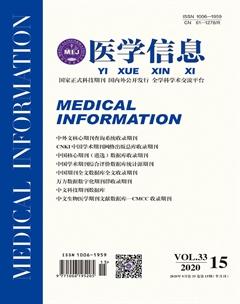类风湿性关节炎的生物标志物及其测定
陈朴阳 刘涛 范凯健
摘要:生物标志物对于指导类风湿性关节炎的临床治疗和管理起着重要的作用,有助于预测高危人群的疾病进展。血清中相关标志物的检测可为治疗方案的选择和治疗效果的评估提供有效信息。各种生物标志物可用于识别易感人群以及患有临床前类风湿性关节炎的人群,并且可以预测骨侵蚀等疾病进展,本文主要对类风湿性关节炎的生物标志物及其测定进行综述,旨在为该病的诊断提供参考。
关键词:类风湿性关节炎;生物标志物;血清
中图分类号:R593.22 文献标识码:A DOI:10.3969/j.issn.1006-1959.2020.15.013
文章编号:1006-1959(2020)15-0037-04
Abstract:Biomarkers play an important role in guiding the clinical treatment and management of rheumatoid arthritis, and help predict the disease progression of high-risk groups. The detection of relevant markers in serum can provide effective information for the selection of treatment options and the evaluation of treatment effects. Various biomarkers can be used to identify susceptible people and people with preclinical rheumatoid arthritis, and can predict the progress of diseases such as bone erosion. This article mainly reviews the biomarkers and their determination of rheumatoid arthritis,designed to provide a reference for the diagnosis of the disease.
Key words:Rheumatoid arthritis;Biomarker;Serum
类风湿性关节炎(rheumatoid arthritis,RA)是一种慢性炎症性疾病,会影响关节、滑膜等。RA是一种最广泛的免疫介导的炎症性关节炎,全球患病率接近1%[1]。RA的患病率在中老年女性中最高。关节损伤主要是骨侵蚀、软骨层变薄,进而导致关节畸形和骨质流失,最终残疾或是功能喪失。RA的早期治疗应采取针对性的治疗策略,客观地使用改善疾病的抗风湿药(disease-modifying antirheumatic drugs,DMARDs)等。近20年来,越来越多的生物药物被开发和使用,有些已经被证明可以显著改善患者的疾病进展。但是,如何更有效地在早期通过检测手段来鉴别RA仍然是目前研究的热门方向。大量的自身抗体和蛋白与RA有显著关系,但是目前只有免疫球蛋白(immunoglobulin,Ig)M类风湿因子(rheumatoid factor,RF)和抗瓜氨酸化蛋白抗体(anti-citrullinated protein antibodies,ACPA)在临床检验中被广泛地使用[2]。这两种抗体在RA患者诊断中具有明显的特异性,且能反应疾病的严重程度。尽管大多在患者血清中能同时发现RF和ACPA,但也有出现过几例单阳性患者[3]。此外,在一些非RA患者中也可能存在RF,因此需要关注一些新型的RA的生物标志物。本文针对RA常见和新发现的生物标志物作一综述,以期为临床检验开展新的检测手段提供一定的参考价值。
1常见的类风湿关节炎生物标志物
1.1类风湿因子 RF是针对IgG的Fc片段的自身免疫球蛋白。RF的种类有很多,如IgG、IgM和IgA RF但目前IgM RF是临床上最主要的检测指标[4]。RF的阳性率会随着年龄的增加而增加,且在老年人口中占比很大。除此之外,RF在一些非特异性慢性疾病中也比较常见,如冷血球蛋白血症和原发性干燥综合症等。在RA患者中能观察到高亲和力的IgG RF抗体,主要是由关节滑膜中的B细胞所产生,且表明B细胞出现了明显的体细胞突变[5]。IgM RF抗体通常是在各种感染和炎症下观察到,但是它通常在其互补决定区缺乏体细胞突变的现象。
1.2抗瓜氨酸化蛋白抗体 ACPA自身抗体是靶向精氨酸脱氨作用后而产生的带有瓜氨酸表位的蛋白质,其靶标特异性取决于翻译后修饰和精氨酸脱氨或瓜氨酸化[6]。当发现瓜氨酸对于ACPA识别的重要性时,研究人员就建立了环瓜氨酸化肽(cyclic citrullinated peptides,CCPs)抗原合成库,以设计具有高度特异性的诊断方法[7]。通过这些测定方法检测到的抗体称为抗CCP。在ACPA阳性患者中,不同CCP表位的检测敏感性不同[8]。近年来,随着抗CCP酶联免疫吸附测定(enzyme-linked immunosorbent assay,ELISA)的不断发展,其灵敏性和特异性越来越高。目前,抗CCP分析方法主要包括抗CCP、抗CCP2和抗CCP3。目前的研究结果显示,抗CCP2和抗CCP3的一致性高达95%,但是抗CCP3可能在RF阴性患者中特异性更好[9]。因此,仍需继续研究提高抗CCP检测的灵敏度和特异性。
2其它类风湿关节炎生物标志物
2.1抗瓜氨酸波形蛋白抗体 抗瓜氨酸波形蛋白抗体(anti-citrullinated vimentin antibodies,Anti-Sa)也是一种特异性抗体,其靶标是波形蛋白[10]。RA的抗Sa抗体特异性与抗CCP2相似,尽管其对早期疾病确诊的敏感性低于抗CCP2,但是抗Sa似乎与较差的预后关系明显胜过抗CCP2[11]。在某些RA人群疾病进展前或是开始DMARDs治疗时,抗Sa的血清水平表达也与抗CCP2不同。有研究发现[12],北美土著RA患者健康亲属中抗CCP2阳性率为15%,而抗Sa抗体则没有表达。Alghamdi M等[13]研究发现,患者在使用DMARDs治疗后,抗Sa滴度明显降低,而抗CCP2的水平仍然保持不变。
2.2抗氨甲酰蛋白抗体 抗氨甲酰化蛋白(anti-carbamylated protein,CarP)抗体靶向含有高瓜氨酸残基的蛋白质。抗CarP抗体在RA患者中的阳性率大概在40%~55%;抗CarP抗体还与CCP抗体相关,但是在血清阴性患者中只有10%的阳性率。Challener GJ等[14]研究还发现,抗CarP和抗Sa还与患者的影像学检查结果存在着很强的关联性。目前,尚未明确抗CarP在RA诊断和预后中的作用。
2.3抗免疫球蛋白结合蛋白 研究发现,人类应激蛋白免疫球蛋白结合蛋白(immunoglobulin binding protein,BiP)会刺激滑膜中的T细胞增殖,并在RA患者中表达升高。Liu Y等[15]和Sun P等 [16]研究发现,RA患者中存在抗BiP抗体,且敏感性和特异性也良好。但是,相当大比例的抗体靶向瓜氨酸化的BiP[17]。因此,抗BiP抗体的重要性仍待进一步研究。
2.4抗RA33 RA33抗体是罕见的中等特异性的RA相关抗体。RA33,也称为异质核糖核蛋白A2/B1,与新生的信使核糖核酸以及其他各种单链RNA和DNA结合。天然RA33抗体和瓜氨酸RA33抗体均存在于RA患者中[18]。不同的是,天然RA33抗体仅存在于早期RA患者中,而瓜氨酸RA33抗体则是可以反应疾病进展情况的标志物[19]。
2.5 Ⅱ型胶原抗体 Ⅱ型胶原(type Ⅱ collagen,CⅡ)抗体在RA患者中很少见,仅在疾病发作时或是在具有较高疾病进展期的患者中其表达比较明显,但是不会随着时间推移而存在[20]。目前,其具体诊断作用仍存在很大的争议性,但是针对天然人Ⅱ型胶原蛋白抗体的早期出现表征了RA的早期炎症和破坏性表型。有文献报道了有关早期RA患者中的抗Ⅱ型胶原蛋白抗体的研究,发现抗CⅡ发生在年龄较小的儿童中,通常与其它自身抗体没有重叠,并且在疾病过程的早期与高水平的C反应蛋白相关。在后续的八年随访中,抗Ⅱ型胶原蛋白抗体与关节损伤显着相关。因此,在疾病病程的早期检测到抗CⅡ可能可以预测疾病八年后的关节损伤。
2.6 14-3-3η蛋白 14-3-3η蛋白是调节细胞内信号传导蛋白质家族中的一员。在RF或是ACPA阳性的健康患者中,血清中14-3-3η蛋白的水平与患RA的风险有显著的相关性[21]。在RA早期观察到,后期会发展成糜烂型关节炎的患者中14-3-3η蛋白的水平较高,但却与C反应蛋白(C reactive protein,CRP)[22,23]无关。有研究显示,RA患者和其它风湿病患者的14-3-3η患病率和血清水平。早期RA患者中14-3-3η阳性的患病率为58%,显着高于疾病对照组和健康受试者的患病率。因此,14-3-3η蛋白可能是RA的有用的诊断生物标志物,且其浓度可用于区分早期RA患者和其它风湿病患者。
3类风湿关节炎抗体的致病性
RF的免疫复合物被认为是类风湿性结节和血管炎的导火索[24-26]。然而,RF本身基本不参与RA的触发初始阶段,它可能继发于慢性炎症。RF还可以通过促进ACPA免疫复合物的形成而与ACPA产生协同作用[27]。RF和ACPA的联合作用表现为,在双阳性患者中表现出更为严重的关节炎症状[28]。在RA早期,ACPA也能被观察到。因此,可能与RA的发病机制密切相关。
4类风湿关节炎相关抗体的测定
4.1常规使用的抗原 大多数RF测试使用的是γ球蛋白或是从兔、人和牛血清中分离出来的Fc片段[29,30]。兔只有一种IgG,牛有2种,而人有4种[31,32]。不过有些研究发现,使用兔IgG虽然可以提高RF检测的特异性,但是其灵敏度会显著降低[33]。用于检测抗CCP的抗原是CCP的专有库,且其灵敏性和特异性也被进行了优化。目前,可以通过微粒聚集或ELISA方法检测RF,但是抗CCP的检测只能是ELISA分析方法。
4.2凝集和浊度法 在早期,RF主要是通过兔IgG包被的羊红细胞凝集来检测的,但是这种方法很难标准化,现已被逐步淘汰[34,35]。比浊技术由于其更高的灵敏度、高度的重复性和便宜的自动化价格而逐步取代凝集法。免疫球蛋白以热聚集、化学交联IgG等形式来在适当温度下触发光散性免疫复合物的形成[36,37]。光的散射程度与RF浓度呈一定相关性。但是,该技术容易受到前区效应的影响,在极高濃度时因抗体出现饱和而导致信号降低[38]。
4.3酶联免疫吸附测定 间接ELISA技术由于其准确性而被广泛用于生物测定。使用ELISA技术进行RF的测定,首先将IgG或其Rc部分吸附到微孔的底部,然后依次添加患者血清的稀释液。使用可定量检测的人免疫球蛋白偶联来揭示与特定抗原反应的免疫球蛋白。使用的抗人免疫球蛋白可以对IgM,IgG或IgA特异,因此可以定量检测IgM RF,IgG RF或IgA RF。抗CCP抗体也可通过瓜氨酸化肽抗原的专有混合物被间接ELISA测定。
5總结
近年来,随着RA生物标志物数量和类型的快速发展,人们对疾病的发病机制也有了更深入的了解。然而,根据目前RA特异性抗体的检测方法,仍然有相当一部分患者是血清阴性的。为了更好地提供RA的临床前和早期检测,寻找到反应疾病活动和治疗效果的特异性生物标志物仍是目前研究的热点方向。
参考文献:
[1]Korani S,Korani M,Butler AE,et al.Genetics and rheumatoid arthritis susceptibility in Iran[J].J Cell Physiol,2019,234(5):5578-5587.
[2]Mc Ardle A,Flatley B,Pennington SR,et al.Early biomarkers of joint damage in rheumatoid and psoriatic arthritis[J].Arthritis Res Ther,2015(17):141.
[3]Humphreys JH,van Nies JAB,Chipping J,et al.Rheumatoid factor and anti- citrullinated protein antibody positivity,but not level,are associated with increased mortality in patients with rheumatoid arthritis:results from two large independent cohorts[J].Arthritis Res Ther,2014(16):483.
[4]Houssien DA,Jo'nsson T,Davi E.Rheumatoid factor isotypes,disease activity and the outcome of rheumatoid arthritis:comparative effects of different antigens[J].Scand J Rheumatol,2009(27):46-53.
[5]Jones JD,Hamilton BJ,Challener GJ,et al.Serum C-X-C motif chemokine 13 is elevated in early and established rheumatoid arthritis and correlates with rheumatoid factor levels[J].Arthritis Res Ther,2014,16(2):R103.
[6]Schellekens GA,de Jong BA,van den Hoogen FH,et al.Citrulline is an Essential Constituent of Antigenic Determinants Recognized by Rheumatoid Arthritis-specific Autoantibodies 1998[J].J Immunol,2015,195(1):8-16.
[7]Fang Q,Ou J,Nandakumar KS.Autoantibodies as Diagnostic Markers and Mediator of Joint Inflammation in Arthritis[J].Mediators Inflamm,2019(2019):6363086.
[8]Aggarwal R,Liao K,Nair R,et al.Anti-citrullinated peptide antibody assays and their role in the diagnosis of rheumatoid arthritis[J].Arthritis Rheum,2009(61):1472-83.
[9]Swart A,Burlingame RW,Gurtler I,et al.Third generation anti-citrullinated peptide antibody assay is a sensitive marker in rheumatoid factor negative rheumatoid arthritis[J].Clin Chim Acta,2012(414):266-72.
[10]Volkov M,van Schie KA,van der Woude D.Autoantibodies and B Cells:The ABC of rheumatoid arthritis pathophysiology[J].Immunol Rev,2020,294(1):148-163.
[11]Hua C,Daien CI,Combe B,et al.Diagnosis,prognosis and classification of early arthritis:results of a systematic review informing the 2016 update of the EULAR recommendations for the management of early arthritis[J].RMD Open,2017,3(1):e000406.
[12]Bidkar M,Vassallo R,Luckey D,et al.Cigarette Smoke Induces Immune Responses to Vimentin in both,Arthritis Susceptible and Resistant Humanized Mice[J].PLoS One,2016,11(9):e0162341.
[13]Alghamdi M,Alasmari D,Assiri A,et al.An Overview of the Intrinsic Role of Citrullination in Autoimmune Disorders[J].J Immunol Res,2019(2019):7592851.
[14]Challener GJ,Jones JD,Pelzek AJ,et al.Anti-carbamylated protein antibody levels correlate with anti-Sa(citrullinated vimentin)antibody levels in rheumatoid arthritis[J].J Rheumatol,2016(43):273-281.
[15]Liu Y,Wu J,Shen G,et al.Diagnostic value of BiP or anti-BiP antibodies for rheumatoid arthritis:a meta-analysis[J].Clin Exp Rheumatol,2018(36):405-411.
[16]Sun P,Wang W,Chen L,et al.Diagnostic value of autoantibodies combined detection for rheumatoid arthritis[J].J Clin Lab Anal,2017,31(5):e22086.
[17]Shoda H,Fujio K,Shibuya M,et al.Detection of autoantibodies to citrullinated BiP in rheumatoid arthritis patients and pro-inflammatory role of citrullinated BiP in collagen-induced arthritis[J].Arthritis Res Ther,2011(13):R191.
[18]Ceccarelli F,Perricone C,Colasanti T,et al.Anti-carbamylated protein antibodies as a new biomarker of erosive joint damage in systemic lupus erythematosus[J].Arthritis Res Ther,2018,20(1):126.
[19]Kang EH,Ha YJ,Lee YJ.Autoantibody Biomarkers in Rheumatic Diseases[J].Int J Mol Sci,2020,21(4):1382.
[20]Manivel VA,Mullazehi M,Padyukov L,et al.Anticollagen type II antibodies are associated with an acute onset rheumatoid arthritis phenotype and prognosticate lower degree of inflammation during 5 years follow-up[J].Ann Rheum Dis,2017(76):1529-1536.
[21]van Beers-Tas MH,Marotta A,Boers M,et al.A prospective cohort study of 14-3-3h in ACPA and/or RF-positive patients with arthralgia[J].Arthritis Res Ther,2016(18):76.
[22]Maksymowych WP,van der Heijde D,Allaart CF,et al.14-3-3h is a novel mediator associated with the pathogenesis of rheumatoid arthritis and joint damage[J].Arthritis Res Ther,2014(16):R99.
[23]Carrier N,Marotta A,de Brum-Fernandes AJ,et al.Serum levels of 14-3-3h protein supplement C-reactive protein and rheumatoid arthritis-associated antibodies to predict clinical and radiographic outcomes in a prospective cohort of patients with recent-onset inflammatory polyarthritis[J].Arthritis Res Ther,2016(18):37.
[24]Bang S,Kim Y,Jang K,et al.Clinicopathologic features of rheumatoid nodules:a retrospective analysis[J].Clin Rheumatol,2019,38(11):3041-3048.
[25]Makol A,Matteson EL,Warrington KJ.Rheumatoid vasculitis:an update[J].Curr Opin Rheumatol,2015(27):63-70.
[26]Makol A,Crowson CS,Wetter DA,et al.Vasculitis associated with rheumatoid arthritis:a case-control study[J].Rheumatology(Oxford),2014,53(5):890-899.

